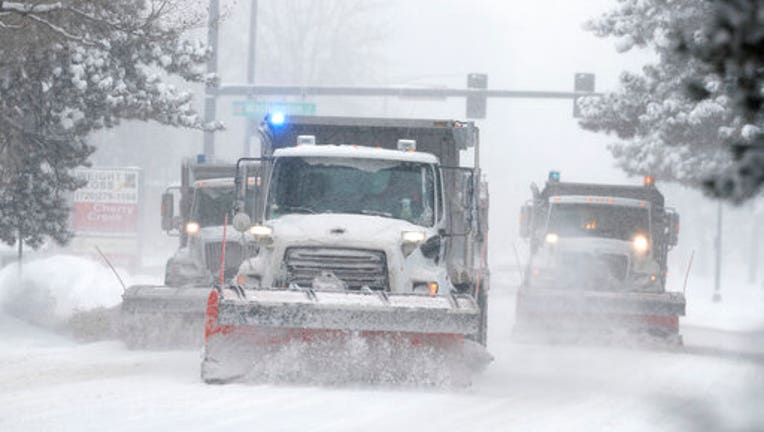Winter storm threatens to scramble Thanksgiving travel plans

City of Denver snowplows clear the eastbound lanes of Speer Blvd. as a storm packing snow and high winds sweeps in over the region Tuesday, Nov. 26, 2019, in Denver. Stores, schools and government offices were closed or curtailed their hours while on
MINNEAPOLIS (AP) — A day after bringing havoc to the Rocky Mountains, a powerful winter storm rolled across the Midwest on Wednesday, threatening to scramble Thanksgiving plans for millions of people during one of the busiest travel weeks of the year.
The storm, which was blamed for one death and hundreds of canceled flights, pushed east into South Dakota, Iowa, Michigan, Minnesota and Wisconsin. It dropped close to a foot of snow in some areas even as the weather system weakened and headed toward New York and Pennsylvania, the National Weather Service said.
But the West was not free of heavy weather. A “bomb cyclone”— a system that triggers a rapid drop in air pressure — brought snow to the mountains and wind and rain along the California and Oregon coasts. Drivers on Interstate 5 near the Oregon-California border spent 17 hours or more in stopped traffic as blizzard conditions whirled outside. Some slept in their vehicles.
"It's one of those things, you couldn't make it up if you tried," National Weather Service meteorologist Brent Hewett said of back-to-back storms forming around the holiday.
Christina Williams and her 13-year-old son, who live in Portland, Oregon, got stuck in the storm as they tried to drive to the San Francisco area for Thanksgiving. Williams said she and other stranded drivers all around her connected on Twitter using weather-related hashtags and began to communicate to find out what conditions were like in other parts of the backup.
“There were spinouts everywhere. There were trucks that were abandoned. And every time we stopped and started moving again, there were people who couldn't start moving again,” Williams said. “Every time we stopped I was like, ‘Is this it? Are we going to be here overnight?’”
It took more than 17 hours to reach Redding, California, where they got a hotel room, she said.
Snow and downed trees and power lines closed roads. Others were reduced to a single lane, transportation officials said.
Minneapolis awoke to as much as 9 inches of snow. Drivers were warned to stay off the roads at least until the winds died down.
“If you can wait a little bit today, the better off you’ll be because the roads will be being cleared, and our snow is pretty much wrapping up,” said Tyler Hasenstein, a weather service meteorologist in Minneapolis.
At the city’s main airport, Delta Air Lines filled de-icing tanks, called in extra flight dispatchers and assigned some of its 20 in-house meteorologists to focus on the forecast.
Airport spokesman Patrick Hogan said three runways were open Wednesday, but Federal Aviation Administration data showed that travelers were still experiencing delays of more than an hour.
At Chicago’s O’Hare Airport, one of the nation’s busiest, the FAA said heavy traffic was causing delays of up to 30 minutes and rising. Airlines worried that things could get worse if winds picked up.
The northern reaches of Wisconsin also saw 7 to 10 inches of snow, with more coming down. The Milwaukee airport reported wind and rain, but there was no snow within a hundred miles of the city.
On Tuesday, weather-related damage and delays were widespread.
About 10 inches (25 centimeters) of snow mixed with winds that limited visibility and canceled about 30% of the 1,600 average daily flights at Denver’s main airport.
Southwest Airlines canceled about 200 flights. Spokesman Brad Hawkins said it would take a couple of days to rebook stranded passengers on other flights because there are few empty seats during the pre-Thanksgiving travel crush.
About 1,100 people spent the night at the airport, including many cadets from the Air Force Academy near Colorado Springs who either missed flights or wanted to get to the airport before road conditions deteriorated, airport spokeswoman Alex Renteria said.
Airport workers handed out blankets, diapers, baby formula, toothbrushes and toothpaste to passengers who camped out on floors and in chairs.
The storm dumped nearly 3 feet (1 meter) of snow in parts of northern Colorado and closed long stretches of highways there and in Wyoming. One person was killed, when a tractor-trailer jackknifed and was hit by two other trucks on Interstate 70 near the ski town of Vail.
Before it’s over, the system’s effects could extend all the way to New England, where a chance of snow was possible over the weekend, said Alex Lamers, another weather service meteorologist.
“That could be a coast-to-coast storm,” he said.
In New York, the system could mean disappointment for fans of the larger-than-life balloons flown at Macy’s Thanksgiving Day Parade.
Organizers prepared for the possibility of grounding the iconic balloon characters because of 40 to 50 mph (64 to 81 kph) wind gusts in the forecast. Rules adopted after several people were injured by a balloon years ago require the balloons to be flown lower or not at all if sustained winds exceed 23 mph (37 kph) and gusts exceed 34 mph (54 kph). The decision will be made on parade day.
___
Slevin reported from Denver. Koenig reported from Dallas. Associated Press writers Thomas Peipert in Denver, Bob Moen in Cheyenne, Wyoming, Olga R. Rodriguez in San Francisco, Gillian Flaccus in Portland, Oregon, Scott Sonner in Reno, Nevada, and Paul Davenport in Phoenix contributed to this report.

